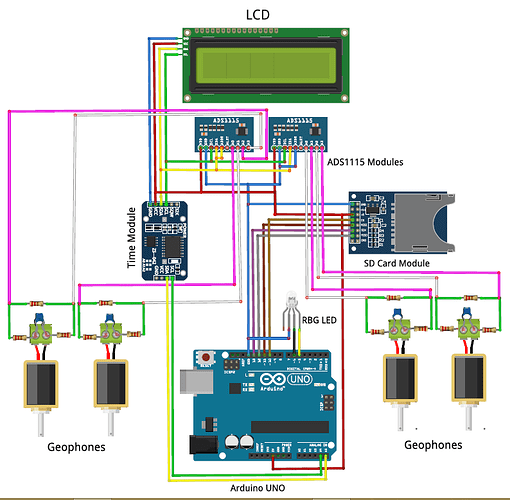Hi, guys. I have been working on this project for a while now. The geophones are thrust into the ground with spikes attached to the bottom. If there is any vibration, the magnets are set into motion. Then, there is a change in the magnetic lines of force, which induces EMF is induced. The induced EMFs are passed into ADS1115 (a programmable amplifier) because the EMF is too small for the Arduino ADC ports to measure. So, I utilize two ADS1115 in this project, and the geophones are attached in a differential mode as seen on the circuit diagram.
What I am having a tough time with is how to use the time stamp from Arduino to know the time it takes (in milliseconds) for each geophone to record an anomaly whenever a button is pressed for the detonation of acoustic waves. Because I want to be using artificial methods of creating vibration. Below is my code for the project.
#include <SD.h>
#include <SPI.h>
#include "DS3231.h"
#include <Wire.h>
#include <Adafruit_ADS1015.h>
#include <LiquidCrystal_I2C.h>
#include <EEPROMex.h>
const int READY_LED = 5;
const int ERROR_LED = 6;
int vibrateDigitalIn = 2;
boolean bIsVibrating = false;
Adafruit_ADS1115 ads_1(0x48); /* Use this for the 16-bit version */
Adafruit_ADS1115 ads_2(0x4A);
//Adafruit_ADS1015 ads; /* Use thi for the 12-bit version */
LiquidCrystal_I2C lcd(0x27,16,2); // set the LCD address to 0x27 for a 16 chars and 2 line display
File Seismic_file;
DS3231 rtc(SDA, SCL);
int CS_pin = 10; // Pin 10 on Arduino Uno
double Voltage1, Voltage2, Voltage3, Voltage4,Time1, Time2, Time3, Time4, Time0;
int addressFloat;
uint8_t Card[8] = {0x1f,0x11,0x17,0x15,0x15,0x16,0x1c,0x7};
uint8_t Card1[8] = {0x00,0x00,0x18,0x08,0x08,0x08,0x10,0x00};
// SM24
const float SM24_V_M_S_FACTOR = 28.8;
String g_recvString = "";
double g_scaleFactor = 1.0;
unsigned long timer = 0;
long loopTime = 5000; // microseconds
uint8_t antiAliasFilterBW = B11; // 50Hz
void setup() {
Serial.begin(38400);
timer = micros();
lcd.init(); // initialize the lcd
lcd.backlight();
lcd.createChar(0, Card);
lcd.createChar(1, Card1);
addressFloat = EEPROM.getAddress(sizeof(float));
pinMode(READY_LED, OUTPUT);
pinMode(ERROR_LED, OUTPUT);
pinMode(CS_pin, OUTPUT);
pinMode(vibrateDigitalIn,INPUT);
digitalWrite(READY_LED, LOW); // turn the LED on (HIGH is the Voltage1 level)
digitalWrite(ERROR_LED, LOW); // turn the LED on (HIGH is the Voltage1 level)
ads_1.setGain(GAIN_SIXTEEN); // 16x gain +/- 0.256V 1 bit = 0.125mV 0.0078125mV
ads_1.begin();
ads_2.setGain(GAIN_SIXTEEN); // 16x gain +/- 0.256V 1 bit = 0.125mV 0.0078125mV
ads_2.begin();
int i = 0;
lcd.setCursor(0, 0);
lcd.print("((((Seismic))))");
lcd.setCursor(2, 1);
lcd.print("Data Logger");
lcd.setCursor(13, 1);
// draw SD card symbol
lcd.write(0);
lcd.setCursor(14, 1);
// draw SD card symbol
lcd.write(1);
delay(3000);
// SD Card Initialization
if (SD.begin())
{
// Serial.println("SD card is ready to use.");
lcd.clear();
lcd.setCursor(0, 0);
lcd.print("SD card is ready");
lcd.setCursor(6, 1);
lcd.print("to use");
delay(3000);
}
else
{
while(1){
// Serial.println("SD card initialization failed");
lcd.clear();
lcd.setCursor(0, 0);
lcd.print("SD card init");
lcd.setCursor(6, 1);
lcd.print("Failed!!!");
digitalWrite(ERROR_LED, HIGH);
delay(1000);
digitalWrite(ERROR_LED, LOW);
delay(1000);
}
}
// Serial.println("Date Time Volt1(mV) Vel1(m/s) Volt2(mV) Vel2(m/s) Volt3(mV) Vel3(m/s) Volt4(mV) Vel4(m/s)\n");
Seismic_file = SD.open("Seismic.CSV", FILE_WRITE);
if (Seismic_file) {
Seismic_file.println("Voltage1(mV), Time1(ms), Voltage2(mV), Time2(ms), Voltage3(mV), Time3(ms), Voltage4(mV), Time4(ms)\n");
// Change this text according
// to what you are measuring; it works as a header for the saved data!
Seismic_file.close(); // close the file
}
// if the file didn't open, print an error:
else {
//Serial.println("error opening Seismic.csv");
}
while(bIsVibrating = (digitalRead(vibrateDigitalIn))) {
lcd.clear();
lcd.setCursor(3, 0);
lcd.print("Waiting for");
lcd.setCursor(0, 1);
lcd.print("(((Shot Waves)))");
digitalWrite(ERROR_LED, HIGH);
delay(50);
digitalWrite(ERROR_LED, LOW);
delay(50);
}
lcd.clear();
lcd.setCursor(0, 0);
lcd.print("(((Shot Waves)))");
lcd.setCursor(3, 1);
lcd.print("Detected!!!");
delay(1000);
}
void loop() {
double output;
digitalWrite(READY_LED, HIGH);
/* Be sure to update this value based on the IC and the gain settings! */
//float multiplier = 3.0F; /* ADS1015 @ +/- 6.144V gain (12-bit results1) */
float multiplier = 0.0078125F; /* ADS1115 @ +/- 6.144V gain (16-bit results1) */
Voltage1 = ads_1.readADC_Differential_2_3()* multiplier;
Voltage2 = ads_1.readADC_Differential_0_1()* multiplier;
Voltage3 = ads_2.readADC_Differential_2_3()* multiplier;
Voltage4 = ads_2.readADC_Differential_0_1()* multiplier;
//VALUES ON SD CARD
Seismic_file = SD.open("Seismic.CSV", FILE_WRITE);
if (Seismic_file) {
Seismic_file.print(Time0);
Seismic_file.print(",");
Seismic_file.print(Voltage1);
Seismic_file.print(",");
Seismic_file.print(Time1);
Seismic_file.print(",");
Seismic_file.print(Voltage2);
Seismic_file.print(",");
Seismic_file.print(Time2);
Seismic_file.print(",");
Seismic_file.print(Voltage3);
Seismic_file.print(",");
Seismic_file.print(Time3);
Seismic_file.print(",");
Seismic_file.print(Voltage4);
Seismic_file.print(",");
Seismic_file.print(Time4);
Seismic_file.print("\n");
Seismic_file.close(); // close the file
}
// if the file didn't open, print an error:
else {
//Serial.println("error opening Seismic.CSV");
}
getSerialData();
output = EEPROM.readFloat(addressFloat);
if(output <= 1.0){
///*
//VALUES ON LCD
lcd.clear();
lcd.setCursor(0,0);
lcd.print("T1:");
lcd.setCursor(4,0);
lcd.print(Time1);
lcd.setCursor(8, 0);
lcd.print("T2:");
lcd.setCursor(12,0);
lcd.print(Time2);
lcd.setCursor(0,1);
lcd.print("T3:");
lcd.setCursor(4,1);
lcd.print(Time3);
lcd.setCursor(8, 1);
lcd.print("T4:");
lcd.setCursor(12,1);
lcd.print(Time4);
sendToPC(&Time1, &Time2, &Time3, &Time4);
}
else
{
///*/
//VALUES ON LCD
lcd.clear();
lcd.setCursor(0,0);
lcd.print("V1:");
lcd.setCursor(4,0);
lcd.print(Voltage1);
lcd.setCursor(8, 0);
lcd.print("V2:");
lcd.setCursor(12,0);
lcd.print(Voltage2);
lcd.setCursor(0,1);
lcd.print("V3:");
lcd.setCursor(4,1);
lcd.print(Voltage3);
lcd.setCursor(8, 1);
lcd.print("V4:");
lcd.setCursor(12,1);
lcd.print(Voltage4);
sendToPC(&Voltage1, &Voltage2, &Voltage3, &Voltage4);
}
}

